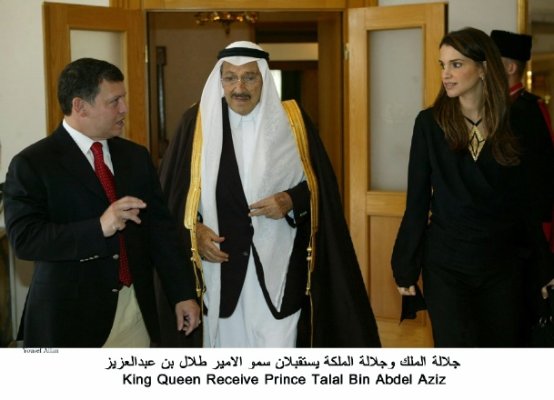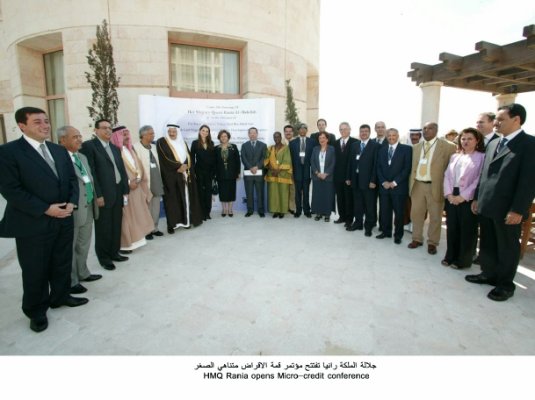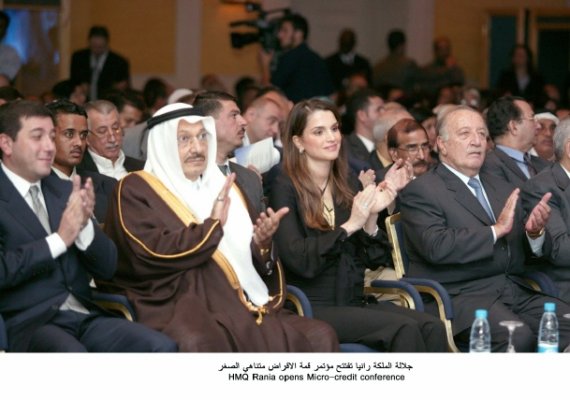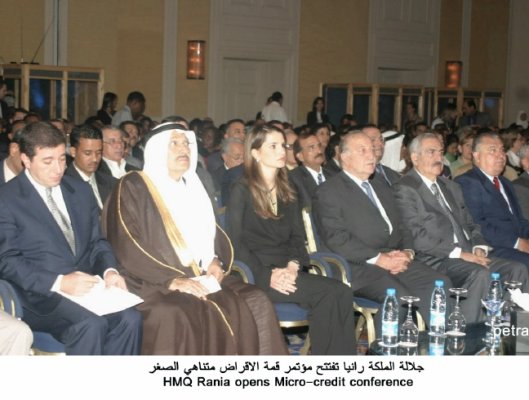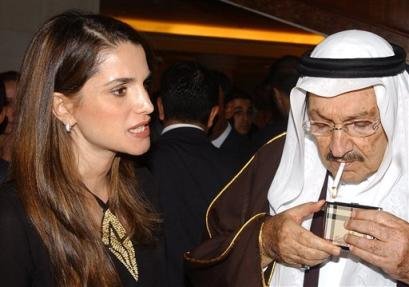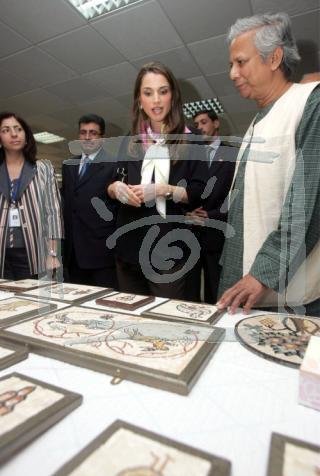Her Majesty Queen Rania shakes hands with one of 23 women beneficiaries of the Microfund for Women during a visit on Tuesday, accompanied by Professor Mohammad Yunis, the founder and managing director of Grameen Bank and the concept of microlending (Photo by Nasser Ayoub)
AMMAN — Her Majesty Queen Rania yesterday underlined the need to combine microfinance initiatives with `business incubators' to further boost credit projects in the Kingdom and reduce running costs.
The Queen's comments were made during a visit to the Microfund for Women (MFW) as part of the 2004 Middle East/Africa Region Microcredit Summit Meeting of Councils (MEARMS) which opened on Sunday in Amman. During the visit, Her Majesty met with 23 women beneficiaries of the MFW and discussed obstacles hindering the expansion of their businesses and ways to further improve their ventures.
Although the women entrepreneurs described how microloans had helped them increase their household income, they also detailed the problems affecting their ventures including a lack of sufficient marketing channels, high interest rates and poor working environments.
Several women described the difficulties of working from home and their inability to differentiate between the running costs of their houses and their businesses when accounting for net income. Such costs include electricity, water and the necessary equipment.
“When I use my tools at home the electricity bill goes up and when the bills come in I can't tell one from the other, and then I cannot decide how much net profit I made because I lose track of my costs,” said Etaf Badwan, who runs a small carpentry workshop from her home in Amman.
Queen Rania's suggestion aims to establish work environments where such women can meet and make use of the facilities and space for their microfunded projects.
According to Jordan River Foundation Director General Maha Khatib, there is only one such `business incubator' in the country located in Amman. She added that more incubators are needed across the Kingdom to help these women improve the nature of their businesses.
Most of the 23 entrepreneurs who displayed their products yesterday said that they had already established their projects before applying for microcredit, and that they did it to either expand their business, or reinvigorate their businesses after incurring losses.
Zohor Mashaleh, who has been making and selling drapes and linen in Zarqa for the past 10 years, said she turned to microcredit one year ago to purchase new equipment for her business.
Muyassar Masri said she has been making and selling fishing nets during the last five years with the help of her unemployed husband, who encouraged her to take microcredit after her business collapsed. All these women agreed that microcredit had led to an increase in their household income, and in most cases, reported it had doubled by the time the loans were repaid.
Another similarity among these women is that after taking microcredit, they were able to employ others, mostly family members including husbands, to work with them as a way to increase production.
Faten Abdullah said with the help of her husband and a small loan, she was able to build a sportswear-making shop that currently employs seven workers.
Out of the 23 women interviewed, 20 said their family income was over JD100 a month before taking the loan. After taking microcredit, their income increased to between JD200 and JD2,000.
The number of microcredit loans among the 23 women ranged from one to 15 loans per person, as was the case of handicraft maker Heba Nasser, who sells most of her production wholesale to tourist shops.
According to MFW General Manager Bassem Khanfar, most women start with small group loans and then take larger loans as their businesses expand.
However, the fact that most of the women interviewed had already established their business before applying for microfinance gives weight to the argument that microfinance fails to target those most in need.
According to the Jordan Human Development Report 2004, “many poor people face significant barriers to access credit.” The report notes that the sector mainly targets the `near poor' and “preferably those with existing businesses” as a means to “reduce transaction costs and minimise the risks.”
Even when credit is available, notes the report, “poor people face significant bureaucratic obstacles in establishing enterprises” such as fulfilling entry requirements and obtaining licences.
Although microfinance for the `near poor' contributes positively towards poverty alleviation, says the report, for the `coping poor' and the `poorest of the poor' there are “significant risks” which may result in “greater indebtedness and dependency.”
Khanfar told The Jordan Times that microcredit is not intended to be given to the “poorest of the poor,” but is given to the “coping poor” whose basic needs are already met so that they can focus on starting a project.
“The poorest of the poor need aid, they care about food and water and physical needs, so if we give them money, they will not be able to generate more money with it because they will satisfy their basic needs with it,” he said.
According to Khanfar, 99 per cent of the loans are repaid. He added that the total number of loans approved by the MFW since its establishment in 1999 is 12,000.
MEARMS is organised by the Arab Gulf Programme for United Nations Development Organisations in cooperation with the Ministry of Planning and International Cooperation and the Microcredit Summit Campaign in Washington, DC and has brought together over 650 participants from 75 countries.


